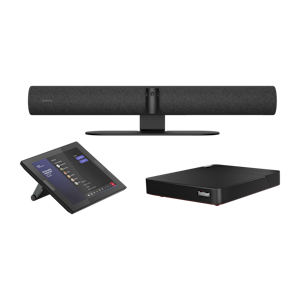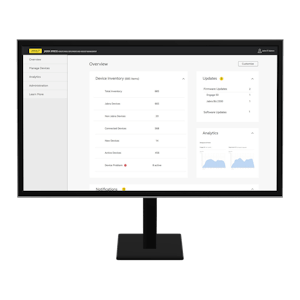Embracing the hybrid wave
The world of work is going through a marked change, and we’re at a pivotal moment. Though more
gradual
and
planned than the pandemic-induced shift to remote work in 2020, the shift to hybrid work is likely
to be
the
biggest permanent shift in work culture for an entire generation.
In our 2021 Hybrid Ways of Working Global Report, we unpack the key trends affecting businesses, as
we
navigate this seismic change.
Leading from the front
At Jabra, although many of us have been working flexibly for years, we’re now navigating the shift
to
hybrid
working across our wider global workforce, and like many companies, evolving our strategy as we
learn.
Although last year’s sudden shift to remote work was disruptive, we learned that it was not only
possible, but
beneficial to work even more flexibly.
Reading the room
To help organizations leverage these unique opportunities for themselves, the 2021 Jabra Hybrid Ways
of
Working Global Report unpacks the findings from a study of more than 5000 knowledge workers in five
key
countries around the world.
And because employees are those most impacted by the transition to hybrid ways of working, we’ve
highlighted
some of their most illuminating perspectives on topics covering the future of the office, inclusion,
and
equity in hybrid models, as well as how employees view trust, culture, and teamwork in a
work-from-anywhere
future.
There’s much more to discover
Read the full report to explore these insights and expert perspectives in more depth, and to
understand
the
key points for consideration as you map out your hybrid working future.
Download the full report
Jabra hybrid Ways of working: 2021 Global Report
The trends
 Location
Location
While 2020 taught us many lessons, the biggest
shift to our working lives was location-based.
We shifted our primary work location from the
office to home, and realized that with the right
tools, we could be productive and maintain
business continuity throughout remote working.
So much so, that most employees now consider the
majority of their tasks as possible from home. Our
research showed that knowledge workers feel most
tasks can be better accomplished from home, with the
exception of collaborative work, where engagement,
socializing, meetings, and onboarding new employees
are considered far more effective in person.
Here are the key location-based trends impacting the
future of the office and where employees get their
best work done.
01
Offices spaces will be seen as
an added resource for social
and collaborative tasks
Knowledge workers primarily want to use offices for collaborating in
meetings, socializing and training team members, or onboarding new
employees. For many though, the office will center around informal
collaboration opportunities, with 71% of the global workforce seeing the
office as a social amenity, while independent work will happen off-site.
Office spaces are a clear preference
for social and collaborative tasks
In order to maximize the resource of an office, employees should experience something
special that you couldn’t accomplish at home. First and foremost, the office is not the
primary place to work. That’s a very important message companies should provide to
employees. There are other more important reasons we want people to come back to
the office. It’s a place where you act as a team and where you come together with your
coworkers. It’s about coming together and getting “we” work done together, not “me”
work. It’s about building culture and camaraderie.
Holger Reisinger,
SVP, Jabra
Next
Steps
Organizations should consider the value of unstructured interactions
and informal collaboration in the office and how much their teams
will benefit from information exchange or networking. This requires
rethinking how offices are designed and how to guide employees on
their use.
Flexible hot-desking arrangements, dedicated collaboration spaces with
whiteboards, and library-like zones, are all examples of different zones
you should look at creating in your new office layout. By creating this
campus feel, you can facilitatethe
type of hybrid environment that
brings employees together in offices again for the right type of face-toface
interaction.
73%
agree that "in the future, having office space will be considered an employee benefit rather than a mandatory way of working”
02
First impressions count
– reasons for return could
potentially be misread
For many people, a desire to return to work might not be because of the
reasons managers think. The dominant pain points for remote workers
are reduced team connectivity and motivation, as well as equipment
challenges, but this may be because of poor organizational support
helping employees adapt with the remote working transition.
Rather than mandating a return to the office, we need to enable people to work from
anywhere, and then positively say that it’s okay to come into an office space however
often or not they want to.
Holger Reisinger,
SVP, Jabra
Employees are more likely to request more days working in office – 3 days
or more a week – if their company did not do a good job transitioning to
remote work during the pandemic, with 17% wanting to be in the office
full time, compared to 14% for those who had a good experience with
the remote work transition.
Because of this, organizations should not jump to the conclusion that
employees want to come back to the office because leadership has
created an accommodating space for work and culture; it could just
as likely mean that lacking trust and support for flexible remote work
created greater challenges.
Work from home challenges
differ around the world
agree that “in the future, having office space will
be considered an employee benefit rather than
a mandatory way of working”
France & Japan
Lack of work and
home boundaries
USA, UK, Germany
Lack of connection with my
team and feeling isolated
Next
Steps
In formalizing hybrid-work strategies and agreements, make sure to
understand the driving factors and uses for which employees want
to return to the office. Our research confirms the findings of many
other studies that show that those in senior leadership positions
usually display higher confidence levels in returning to the office than
employees. In this light, it is key to understand that home working
challenges do not directly correspond to return-to-office drivers.
 Leadership
Leadership
The puzzle of hybrid work poses one of the
greatest management challenges of modern times.
Capitalizing on the benefits of flexible and remote
work, while re-utilizing the office as a renewed
resource is a complex problem to solve in order to
enable an equitable workforce. Hybrid itself is not a
remedy; there will be a spectrum of implementation,
and it is up to leaders to align and evangelize healthy
practices that work for a specific company in order to
foster high performing teams of individuals.
While each organization needs to consider its own
unique needs to optimize hybrid work productivity,
standardizing these practices such that they meet the
unique complexity of each employee’s ideal hybrid
working preferences is a challenge. Threading the
hybrid needle will require new leadership perspectives
built on the insight of knowledge-worker preferences
and viewpoints.
01
Organizations must communicate
clear principles, but will suffer
from policies
Much of the complexity for management lies in designing return to the
office policies that maintain employee autonomy and flexibility while
still encouraging ways to bring people together for meaningful activities.
Three in four knowledge workers say they have concerns around a hybrid
work future (74%), but most of the reasons driving this come down to
sound leadership and communication practices.
3 in 4 have concerns around
a hybrid-work future

While knowledge workers are seeking clear guidance on company-wide
expectations for hybrid work, they still desire flexibility and autonomy to
make individual decisions on how best to get their jobs done. Majorities
believe managers can make a hybrid work environment as comfortable
as possible by allowing team members to set their own schedule (65%),
instead of holding standard 9-to-5 working hours (35%). A similar
percentage would prefer that management allows team members to
come into the office when they need to and work from home when they
need to (61%), over setting “in office” and “at home” days each week for
the team (39%).
Top 3 concerns about hybrid working future
Lack of clear expectations around when or how often
to go into the office or what type of work to go in for
28%
Lack of consistency of hybrid working
best practices across my company
26%
Lack of equal opportunities for employees
who chose to work from home more often
25%
The majority also see a path forward for companies to solve these complex issues,
most notably with simple steps, such as establishing clear guidelines on when to
go into the office and setting clear expectations for communications and reporting.
Rather than setting formal policies in place, leadership should focus on creating
high-trust environments in which principles and guidelines are communicated,
making expectations clear for employees while allowing them to retain autonomy
and maximize their flexible working arrangements.
Top 3 requests for leadership in hybrid
Establish clear guidelines around when to go into the office
39%
Set clear expectations for communications and reporting
35%
Communicate consistent company-wide
expectatoins for hybrid work
34%
Generally, people appreciate clear guidelines. If it’s only about policies, you are missing a human
element.
But if you have guiding principles, you are communicating that you trust people to do what is best.
When leaders are very strict on saying what people should not do, employees get more concerned and
have a higher need for reassurance, which stalls productivity. Having too many strict rules makes
things
complicated and frustrates people. People can really deal very well with autonomy, and they
appreciate
the flexibility.
Holger Reisinger,
SVP, Jabra
02
Companies that consult
employees will win in the
long run
Throughout the pandemic, leading organizations have communicated
more consistently with their employees, and equally listened to the
input and feedback from managers and teams undergoing the transition
to remote work. Now, as the shift to hybrid is implemented, 86% of
employees think that careful work guidelines are needed for an equitable
hybrid workplace.
Considering the opinions of multiple stakeholder groups can be a
complex process, but 85% of all knowledge workers we surveyed would
value consultation before implementing any hybrid working practices.
Companies that consult with employees are likely to see more success
in hybrid. And even if they don’t agree with all of them, consulting with
employees will lead to higher satisfaction with new practices and broader
buy-in and adoption into hybrid ways of working.
Almost everyone has been forced to adjust their schedules, which for many
means a permanent rearrangement of their private life, homeschooling
children, or taking care of older family members. There is no one-size-fits-all
approach to organizational management. Each company, each team, and
each individual will have to figure out what works best. It will be an iterative
process requiring patience and compromise from all.
Holger Reisinger,
SVP, Jabra
 People
People
The pandemic disruption affected every person
uniquely, and made work much more personal for
everyone, as the boundaries blurred between our
home and working lives. To help people thrive in more
flexible working environments, every organization
needs to plan processes and guidelines that drive
a people-first agenda. This means emphasizing
empathy, culture, and the tools and training needed
for a work from anywhere future.
These are the key insights from our research that
can be used when considering your people practices
in hybrid work.
01
Flexible working is more
important than salary
and other benefits
For many knowledge workers, it is not just the ability to work from either
home or office, but the ability to work from anywhere, that is a true
differentiator. With 75% of knowledge workers wanting to work from
wherever they are in the future, organizations need to rethink benefit
structures to remain competitive.
Flexibility is so important to the workforce that 59% of knowledge
workers assert that it is more important to them than salary and other
benefits. With employees able to access a broader range of employment
options, the fundamentals of labor supply and demand have shifted
in employees’ favor. Hybrid work has catalyzed a power shift from
organizations to employees and employees have realized that there is a
smarter way to work and a more tailored way to integrate their personal
and professional lives with flexibility.
At Jabra, many of us have been working flexibly for years, and with hybrid work we’re
excited to be navigating this at greater scale. As a global organization, high trust has
always been key to giving our employees the freedom to work anywhere. We’re used to
collaborating in meeting rooms, virtually, in hybrid situations, through time zones, and
across borders. If you couple this attitude with the right technology and train your leaders
how to effectively manage hybrid teams, you can attract top talent from anywhere in the
world by promising them the flexibility they’re looking for.
Holger Reisinger,
SVP, Jabra
Since the pandemic began, 48% of all employees surveyed globally have
considered changing jobs. 81% have said that a hybrid work model will
allow more intentional use of time and spaces in order to ultimately be
more productive. As employee priorities change, and new ways of working
are realized, organizations need to reconsider their workplace practices
and benefits in order to remain competitive and attract the best talent.
81%
agree that "organization who embrace a hybrid model will have a competitive
edge in the future”
Give people more autonomy to decide themselves where they are at their best,
but leaders need to make equally sure that if employees choose to work from
a location other than the headquarters, that they don’t feel left behind.
Holger Reisinger,
SVP, Jabra
02
A hybrid working model with
the right technology will lead
to better employee mental
well-being
While working remotely, anxiety levels rose, people worked far longer
hours, and our research showed that lacking boundaries between our
personal and professional lives consistently ranked as one of the biggest
challenges around the world while working from home. During remote
work, our research showed that sense of connection amongst teams
decreased 28%, feelings of recognition decreased 17%, and employees’
feeling of closeness to their direct manager decreased 21%.
Conversely, nine in ten knowledge workers say a hybrid environment
would either increase or maintain a sense of trust in their team (90%),
the level to which they feel their employer cares about their well-being
(89%), and the level of recognition they feel for their contributions (89%).
Emotional intelligence and empathy have never been more important; leaders need to get across via
video
that which traditionally has been done in person. They need to show, to really show, that they care
about the
well-being of their employees. This takes a foundation of well-trained people management practices,
which
can be further enhanced by data.
Holger Reisinger,
SVP, Jabra
As the preferred model for the majority (68%) of employees, hybrid
work can offer employees the flexibility to better balance their time,
while technology coupled with clear guidelines can address the major
concerns with hybrid work models and lead to higher performing teams
with a healthier work-life balance.
Knowledge workers believe hybrid working
will increase their work well-being
“ A hybrid work environment
would increase or maintain”
Closeness to senior leadership
85%
Connection with manager
85%
Feeling of recognition
88%
Degree to which your employer cares about your wellbeing
90%
Sense of trust in your team
89%
Next
Steps
One key action which leaders can take right now is to provide seamless
collaboration solutions as well as opening up conversations about
hybrid-work changes and employee well-being. When people have
humanized collaboration experiences that make connecting from
anywhere possible, it facilitates better inclusivity and teamwork.
When leaders combine this with open team dialogues, it creates
a common language and toolkit with which to address stress.





















 Location
Location Leadership
Leadership People
People



